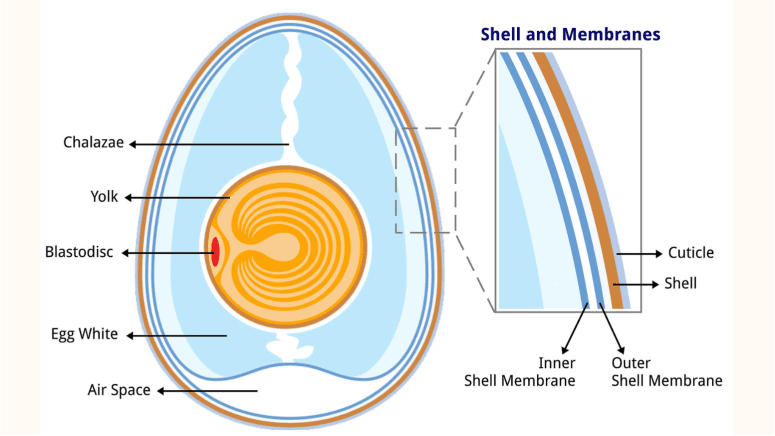Posted by Melissa Caughey, Tue, Apr 4, 2017; updated Tue, Dec 19, 2023
Now that you are a chicken keeper and realize how different fresh eggs look and taste, have you ever cracked an egg into a dish and wondered what all those parts are?
You are not alone, and today I thought it would be nice to share and explain exactly what you are seeing. Let’s start with the shell.

Egg Shell
The outer shell is the outermost part of the egg and offers protection for the inside of the egg. It is comprised almost entirely of calcium carbonate and has almost 17,000 pores, which allows for the exchange of moisture and air between the egg and the environment.
Stronger eggshells can be attributed to chickens that have had access to oyster shells for calcium. Every egg has a clear cuticle, or “bloom,” which coats it immediately as it leaves the chicken’s body. This helps to keep out dust and bacteria.
Immediately inside the egg are two membranes, called the inner and outer membranes. These membranes form a second barrier to prevent bacteria from entering the egg. They are quite strong and made of keratin.
The air space is located between these two membranes at the rounded end of the egg. Air inside the shell affords the chick the ability to breathe when needed during the development process. Interestingly, as eggs age the air space becomes greater from air entering naturally through the shell’s pores. A larger air space allows for easier peeling of hard-boiled eggs.
Egg White
Next, we discover the egg white. The egg white is comprised mostly of albumen and water. It contains approximately 40 different proteins and would provide food for the baby chick if this egg were fertilized and allowed to develop. The embryo develops inside the cushioned, protective egg white.

Egg Yolk
In the center of the egg is its most familiar component: the yolk. The blastodisc sits on the yolk and is made up of a single layer of cells that, when fertilized, can become a chick embryo in the proper environment.
The egg yolk is a major source of vitamins and minerals, as well as cholesterol and fat, that the baby chick requires in order to develop properly. The color of the yolk depends greatly on the chicken’s diet but normally ranges from deep orange to dark yellow.
The egg yolk is held in place by the chalazae. Made from a protein called mucin, these cordlike fibers work to center the yolk in the egg. Of note is the fact that the more visibly prominent the chalazae, the fresher the egg.
Benefits of Eating Eggs
Eggs are often considered the perfect food. Each egg is only 75 calories but packed with seven grams of high-quality protein. They contain many vitamins, minerals, and antioxidants and are naturally gluten-free.
Try creating meals based on eggs for your family. They are versatile and perfect for breakfast, lunch and dinner.
How to Help Your Chickens' Eggs Grow Strong
Manna Pro® offers Oyster Shell, a crushed, pellet-size source of calcium. Oyster Shell helps build strong eggshells for your birds, and is both heat-treated for purity and great for cleaning corn-burning stoves!


